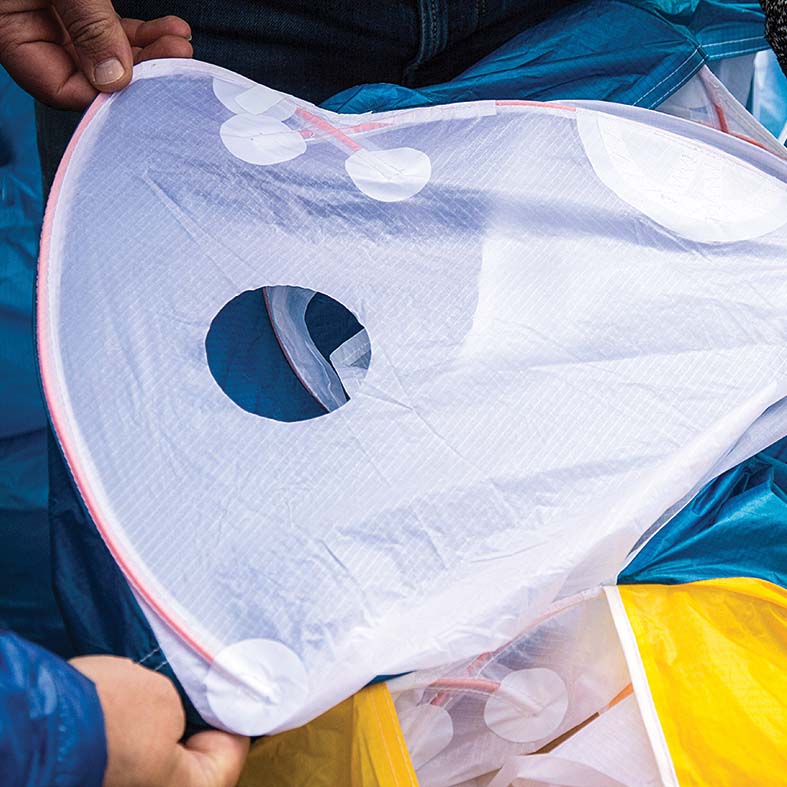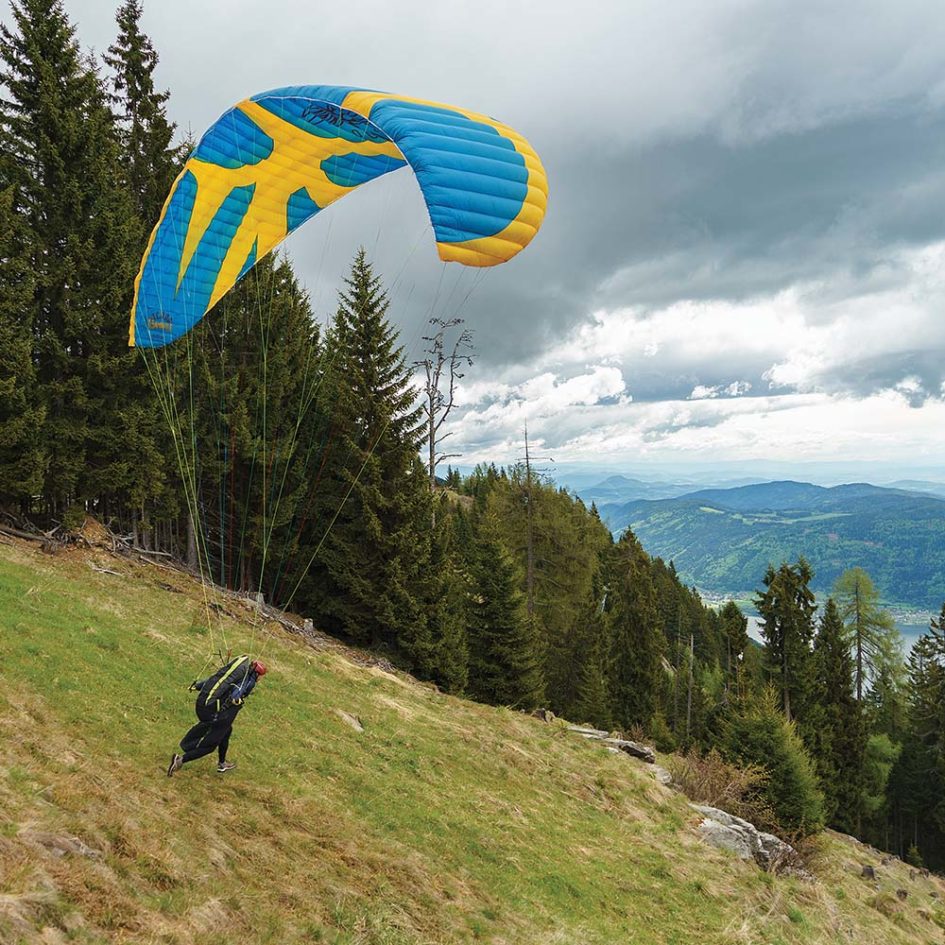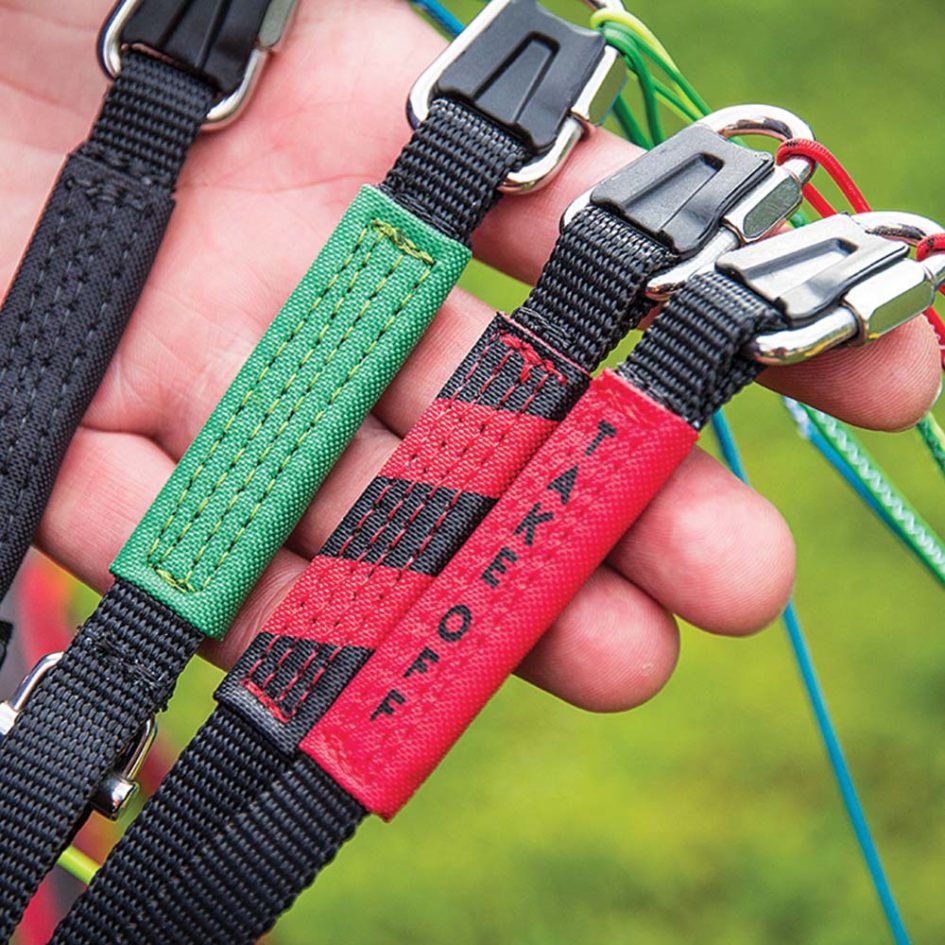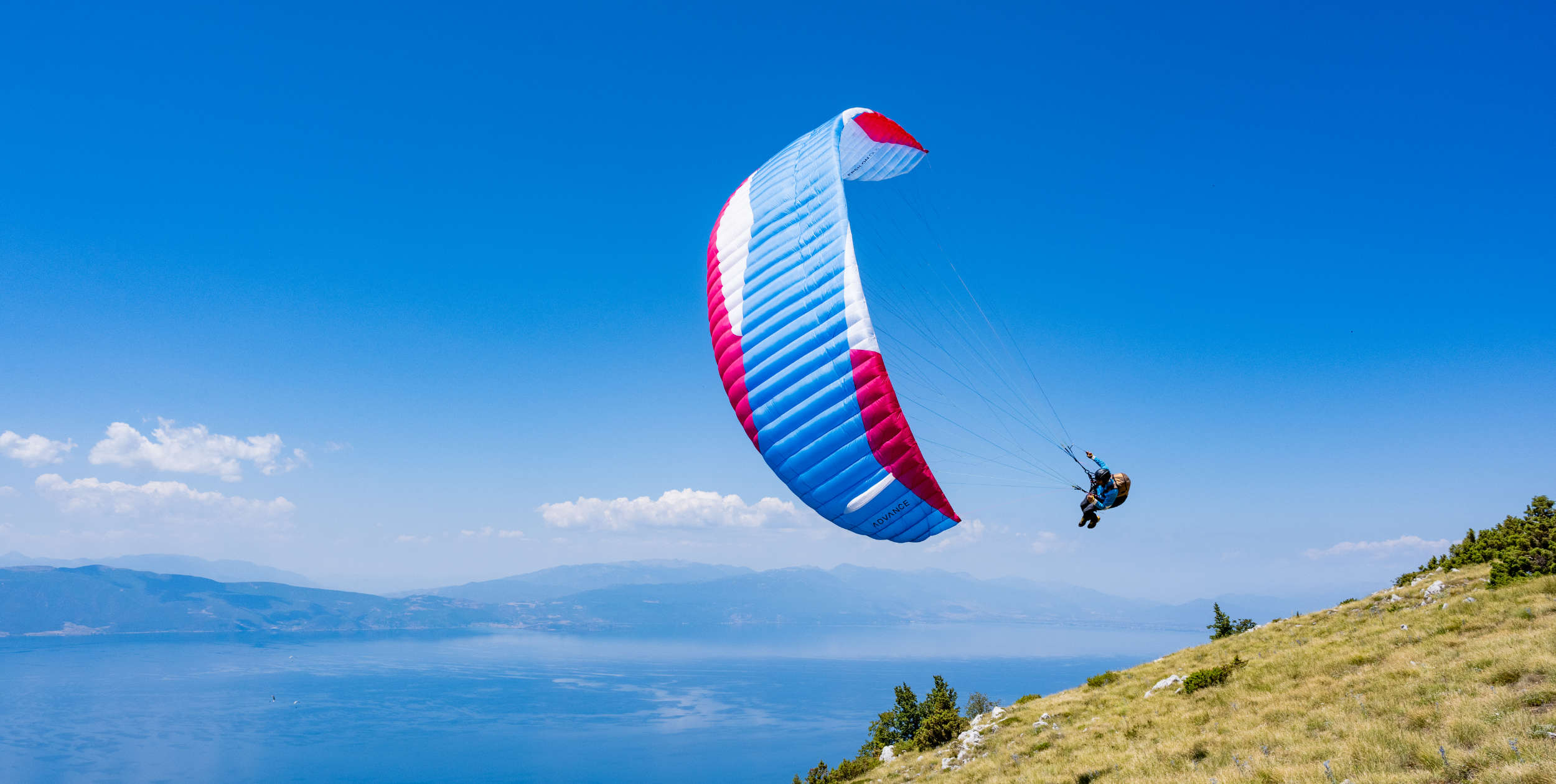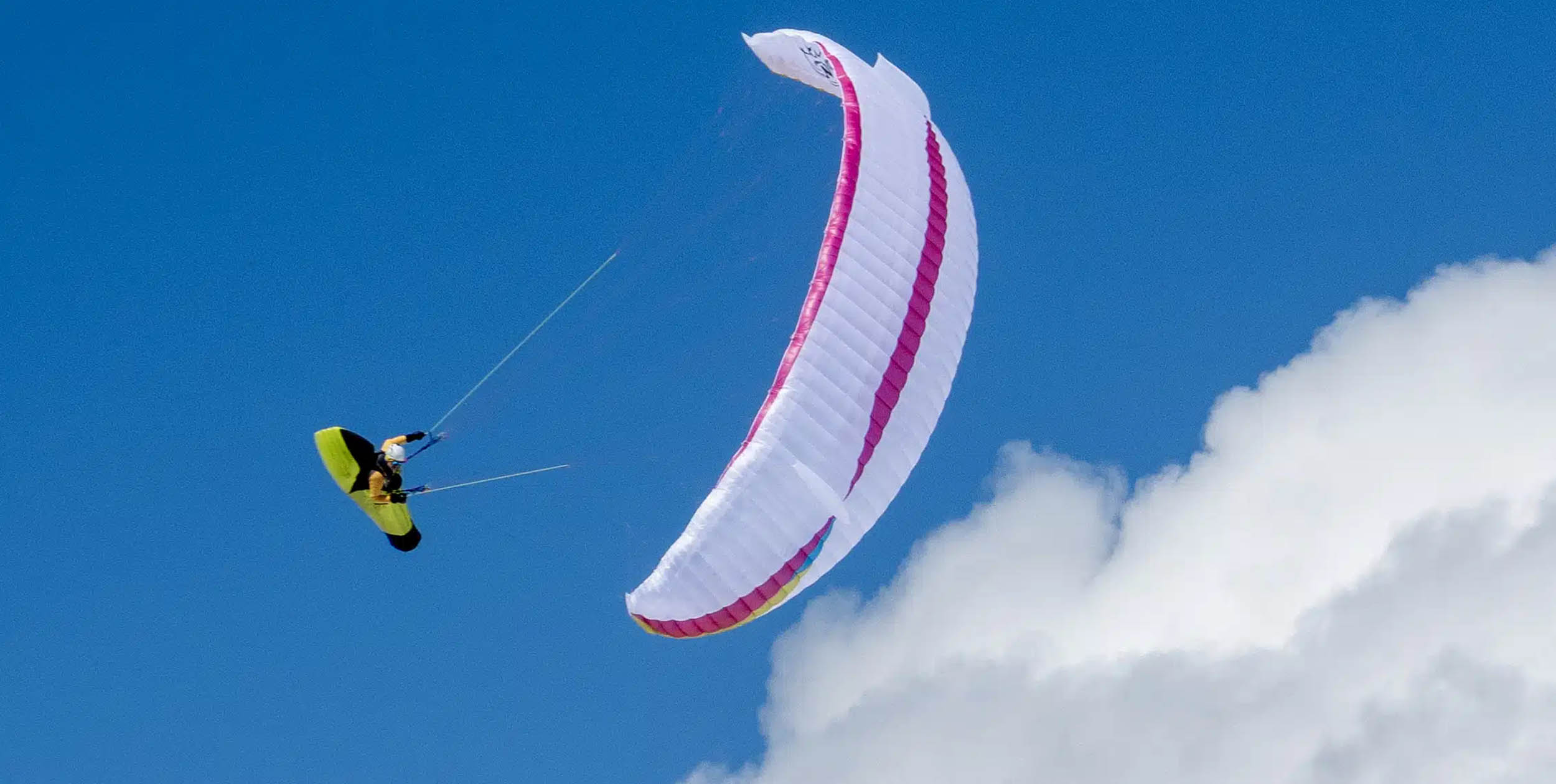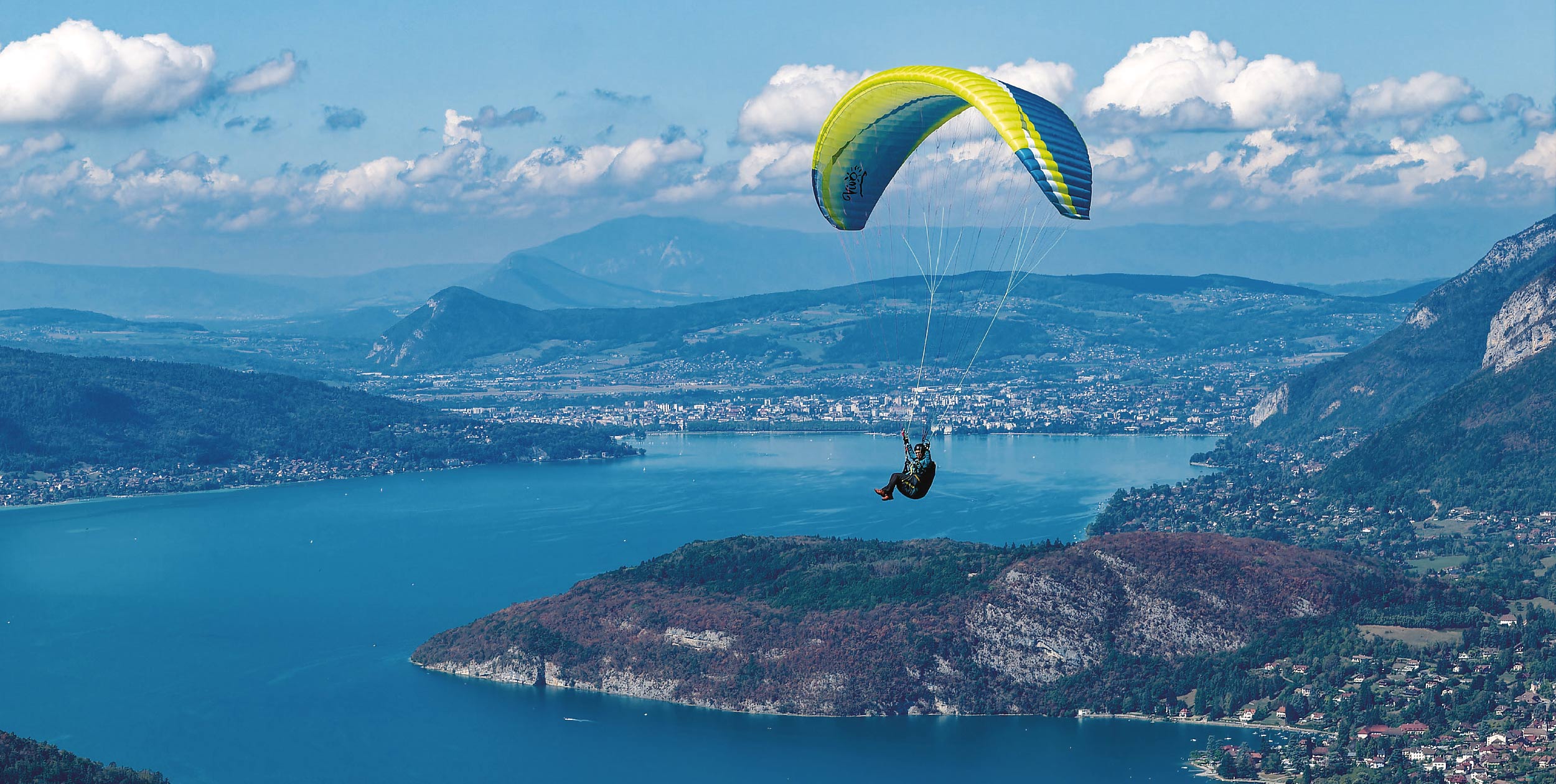This mid-EN B wing comes packed with personality. Ed Ewing tries it out on the company’s home turf
Icaro have been around a long time. They grew out of the hang glider company Fly and More, founded in 1992. The paragliding arm was born in 2000, and the company went on to become known for their acro and freestyle wings. One of several smaller German brands that have always had their niche, they are big in Japan and also successful with schools.
They have never been afraid to experiment. Most recently they broke the mould and attempted to crack the dominance of the EN system with the Sitta, a hike-and-fly wing that, because they loved the sweet handling, they allowed to be certified as an EN D wing. The glider only scored EN D on exit from spiral, and was an EN A/B wing in all other respects.
It was a brave move, but not one that really paid off in sales. There are dozens of hike-and-fly gliders on the market, and your average Alpine Sunday flyer is never going to go for an EN D over an EN B, no matter how hard you try to communicate that it’s “really an EN B”.
Just over two years ago, Benni Hörburger, 30, joined the company with new ideas and a bucketload of talent. A young and energetic test pilot who has been around free flying all his life he is now head of research and development and chief test pilot at Icaro.
He comes from a family of pilots – his father still runs Germany’s longest established hang gliding and paragliding school and Benni first flew paragliders solo when he was six. Aged 14 he came seventh in his first week-long competition and was already a licensed hang glider pilot too. He flies planes, Swifts, gliders, paramotors, miniwings and trikes, too. In his words, “I fly all.”
Eschewing mainstream education for flying he went to work for Swing when he was 17, where he worked side by side with designer and test pilot Torsten Siegel (now of GIN). From there he worked with legendary designer Hannes Papesh on projects for Nova and Advance (the Alpha 4 and Epsilon 8) before being offered a job at Icaro.
“I said I would do it,” he explained. “but first I wanted to see the manufacturing, and second I wanted to choose my own team of pilots to work with.” His theory is that many companies have “too many chiefs” and not enough pilots flying the wings with real-world feedback. As a designer he wanted to work for a small company or not at all.
“I saw the manufacturing in Sri Lanka was very good, and so I was happy. And I was allowed to choose my own team.”
He worked first on the Parus, the company’s tandem wing, before overseeing the Nikita 5. For the last 18 months he has been working on the Gravis, a fun-packed mid-EN B wing aimed squarely at the recreational market – everyone from newly qualified pilots with feeling through to time-served XC pilots looking for good security. Like Benni, it’s loaded with personality and a lot of fun. It is also technically sophisticated – but simple to launch and fly.
First flight
Getting up at 3.45am to catch a 6.15am flight is never fun, but by 10am we were on the road south from Munich towards Icaro’s home base near the Austrian border. There are literally half a dozen flying sites nearby, however, it was pouring with rain and so after a quick lunch stop we were on the road again, destination Gerlitzen.
Along for the ride was Xandi Meschuh, an acro legend who has flown and worked with Icaro for years. The 41-year-old pilot’s laidback demeanour is the perfect foil to Benni’s infectious enthusiasm. Arriving at launch late that afternoon Benni pushed for us to fly straightaway while Xandi pointed out we had been up early. Benni won.
The 1,500m lower launch in Gerlitzen is wide enough for a handful of gliders and is a steep grassy strip between the trees. It is protected from the proper wind 50m out, potentially giving a false sense of security. That, its steepness, and the line of thick trees below it mean it could be termed intimidating for newish pilots.
Laying out the new glider and clipping into the new Icaro-supplied harness on this new launch, I did question again the wisdom of moments like these. The rain dropping out of the clouds at the head of the valley didn’t look great either.
“Launch using just the one line,” said Benni, pointing at the split-A riser clearly marked ‘Take Off”. A genuinely helpful touch.
Lifting them between thumb and forefinger, my arms in the classic W-position, with a little tension on the single A-line, I eased forwards at a walk. In the old days pilots had to run hard from the off but modern wings need none of that: simply stepping forwards most good gliders rise responsively.
The Gravis did just that with no feel of overshooting or drifting off to one side. Running down the strip I was off, with Marcus behind.
My immediate thought was it was nimble and quick. I was flying the 90-115kg size near the top of the weight range, and I zoomed out over the lake feeling like I was in a Smart car.
Everything felt clean and, like the perfect city car, surprisingly spacious. My hands wrapped into the brake handles easily, and when I dropped a brake, it clipped neatly onto the bespoke magnetic keeper by itself. When I wanted it again, it was just there – no grabbing for it in the wind.
My second thought was, “There’s nothing there!” On glide to the lake I rested my hands on the risers, searching for bobbles or hoops on the rear risers as is the vogue. But nothing, just smooth, slim riser to hold. Clarity of design and simplicity of use, not fashion, are watchwords for Benni.
Sitting back to enjoy the sled ride I took the time to look up: there are only seven lines in total each side, while the wing has only 40 cells. The aspect ratio is 5.2, a smidge more than the Nova Ion 4 (5.14), the Ozone Geo 5 (5.15) or Advance’s Epsilon 8 (5.15), which are comparable wings and would be on the same demo list for a pilot looking in this class.
I had one eye on a shower over the lake, drifting east, and another rain cloud arriving from the north to our west. At the landing there was a gentle easterly from the valley flow. I half expected some turbulated air, but the glider simply flew me down to the landing field in good style where a nice flare showed that its landing capability is just as straightforward as its launch behaviour.
Thermalling
The next day we spent more time over the lake, swinging around a bit taking photos and flying close to each other. Hands-off the wing was a baby, responding to weightshift and carving clean quick turns through the air. Over several launches from the same spot the wing again behaved perfectly, including a reverse launch in a bit of a breeze late in the day. This launch behaviour, Benni said, was influenced by his work on the Parus tandem. Working tandem pilots need simple, easy, dependable launch characteristics, and this is what he has given the Gravis too.
My notes from the day read “felt Benni in the glider,” which sounds a bit odd, but means that his personality is definitely in this wing. It’s very safe, with a raft of As in its EN report, but it’s also playful, fun and dynamic.
Our third day was thermic and took us to a different site near Klagenfurt known for its XC potential. Taking off into a slight gusty crosswind from a grassy knoll was again easy. Having a glider you know will launch easily without drama in different conditions is always confidence inspiring.
Flying out across the trees I got lower and lower as others above climbed higher. Damn, I’d missed it! I ended up scratching around close to the cliffs, getting to know the treetops, and being buffeted by the thermic flow up the slope. Turning in scrappy non-thermals, ridge soaring in figure-eights, and diving back and round chasing my tail was the name of the game. The day was not smooth – all the locals agreed later that it was rock and roll due to an approaching southerly wind mixing it up – but the glider performed well. No tucks, no sudden snappy surges, no pitching back horribly.
Finally climbing out in a good one I skimmed around in a series of easy full circles. “There’s Benni!” I thought as I let the outer brake off, built the speed and let the glider fly. Fun going up.
At 500m above launch it was still a rocky day. All the gliders in the air showed signs of the jagged flow and were pitching about. I pushed out front to experiment with the speedbar, which was super-smooth and gave an almost instant extra 10km/h on my GPS at full bar. There was no tentative feeling – the bar is there to be used and the extra speed is 100% accessible.
Turning back I saw Xandi top-land, done with fighting with rocks for the time being. Good call, I thought, and headed over to do the same. To be honest I’d had my eye on the bottom landing field, because of the conditions, but reassured by the glider’s behaviour so far I headed in to the big grassy paddock. Skirting around the trees, and lining up into wind the glider top-landed beautifully, my fears unfounded.
The grand tour
Later, back at Gerlitzen, Benni gave me the full tour of the glider. Like a chef showing you his kitchen, this can reveal a lot. It is clear that Benni is working to a philosophy and structure, not simply punting out ideas. The Gravis is designed as an all-rounder using lightweight construction techniques, not simply lightweight materials.
The difference is important: light materials can mean a higher price and a shorter lifespan, and often the glider is a second wing. Most people don’t have a second wing and want their glider to last, so light construction means using more durable materials in an efficient way on regular wings.
Hence the easy risers and the use of the minimum number of lines possible. Different lines have different strengths, and a working relationship with Liros, the line manufacturer, has allowed Icaro to do clever things like double-splicing the connection loops for added strength.
There is a sharknose – “more a dolphin nose!” laughed Benni, which makes sense considering how playful the wing is – and durable 32g/m2 material used throughout the glider: topsail, bottom and internally. The material is guaranteed for 300 hours under normal use.
Conclusion
We didn’t fly the Gravis on any long XCs, but we definitely got a flavour of what the glider is about. And that is all about fun, security, handling and passion. If you want to fly 200k on a regular day in the flats, look elsewhere; but if you are a ‘talented new pilot’ and in the market for a wing that can help you progress while you learn, while keeping that real sense of dynamism, then it’s on the list.
You won’t grow out of it too quickly; in fact I’d say you’d grow into it and learn a lot from it. For more experienced pilots who fly this class, well there is a lot of choice out there – this one joins the club and lines up nicely against them all. You will appreciate the build, the fabric guarantee, and the attention given to the lightweight design.
Benni has obviously poured his heart into the Gravis. Informed by a lifetime lived around free flight, it is also, I think, created with love. And that is always a powerful thing.
****
Fun Stuff
Despite the safe and secure nature of the Gravis its short direct brakes hint at its playful side. Finding myself over a lake with plenty of height I got the opportunity to explore this side of the glider. I was flying the large size which has a weight range of 90-115kg all up, towards the lower end of the range at about 100kg.
Spiral dives
A pull of the responsive brakes had the wing quickly dropping into a spiral dive. Once in it was easy to regulate the sink rate with brake and weightshift. Exiting was as simple as you get, the direct brakes enabling me to bleed off the energy in the final turn. I also played with asymmetric spirals finding it easy to get good coordination between brakes and weightshift to get that flowing feeling.
Big ears
With only two main A lines on each side pulling the outer one will give you quite large big ears. There is quite a bit of pressure in the wing and you have to hold the ears in with a reasonable amount of force. Combining ears with bar gave a good sink rate with a good forward speed, perfect for running away from clouds. Once released the ears reinflated quickly.
Wingovers
Despite being low in the weight range the wing reacted well to brake and weightshift inputs and it was easy to quickly get above the horizon. The wing retains energy and with the long brake range you can put good strong brake inputs in at the top of the swings to pressurise the wing without fear of overcooking it.
Marcus King
****
Manufacturer’s Specification
What Icaro say: “Combines efficient performance and precision with highest safety characteristics”
Use: A true all-rounder
Pilot level: Intermediate pilots +
Sizes: XS, S, M, L, XL
Flat area (m2): 22, 24, 26, 28, 30
Recommended take-off weight (kg): 55-75, 65-90, 80-105, 90-115, 100-130
Glider weight (kg): 4.1, 4.3, 4.5, 4.7, 4.9
Cells: 40 + 38 (leading edge mini-ribs)
Flat aspect ratio: 5.2
Certification: EN/LTF B
icaro-paragliders.com
To stay up to date and read our reviews first, subscribe to Cross Country


